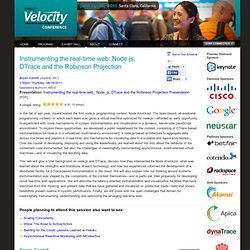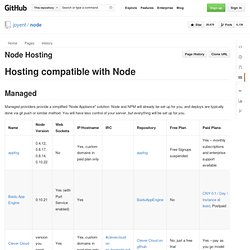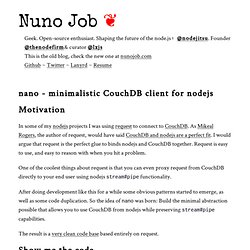

Instrumenting the real-time web: Node.js, DTrace and the Robinson Projection: Velocity 2011 - O'Reilly Conferences, June 14 - 16, 2011, Santa Clara. In the fall of last year, Joyent hosted the first node.js programming contest, Node Knockout.

The team-based, all-weekend programming contest—in which each team was given a virtual machine optimized for node.js—afforded an early opportunity to experiment with novel mechanisms of system instrumentation and visualization in a dynamic, server-side JavaScript environment. To explore these opportunties, we developed a public leaderboard for the contest, consisting of DTrace-based instrumentation for node.js in a virtualized, multi-tenancy environment; a node.js-based architecture to aggregate data across machines and present it in real-time; and mechanisms for visualizing data in a scalable and repsonsive fashion. Table of Contents - Mixu's Node book - Mixu's Node book. Hosting compatible with Node - GitHub. Hosting compatible with Node Managed Managed providers provide a simplified "Node Appliance" solution.

Node and NPM will already be set up for you, and deploys are typically done via git push or similar method. You will have less control of your server, but everything will be set up for you. We open-sourced 90 node.js modules at Browserling! At Browserling we are huge open-source fans and we have open-sourced 90 node.js modules!

That's right! 90 node.js modules. All written from scratch. We crazy! Here is the complete list of all the modules together with their brief descriptions. We'd love if you followed us on GitHub. Also check out Browserling: And read how we raised $55,000 seed funding for Browserling. Here are all the modules we have written. 1. dnode DNode is an asynchronous object-oriented RPC system for node.js that lets you call remote functions. This starts dnode server on port 5050 and exports the zing function that asynchronously multiplies number n by 100.
And you have your client.js: var dnode = require('dnode'); dnode.connect(5050, function (remote) { remote.zing(66, function (n) { console.log('n = ' + n); });}); This connects to dnode server at port 5050, calls the zing method and passes it a callback function that then gets called from the server and the client outputs 6600. dnode on github.
Observer - observing and learning from your customers. Hailstorm - A distributed load tester written in node.js for Node Knockout : programming. Iisnode: Node.js for Internet Information Server : programming. An XMPP server with Node.js : programming. Nuno's Notebook — nano - minimalistic CouchDB client for nodejs. Motivation In some of my nodejs projects I was using request to connect to CouchDB.

As Mikeal Rogers, the author of request, would have said CouchDB and nodejs are a perfect fit. I would argue that request is the perfect glue to binds nodejs and CouchDB together. Request is easy to use, and easy to reason with when you hit a problem. One of the coolest things about request is that you can even proxy request from CouchDB directly to your end user using nodejs stream#pipe functionality. After doing development like this for a while some obvious patterns started to emerge, as well as some code duplication. The result is a very clean code base based entirely on request. Show me the code For your convenience I added all the code snippets to a gist.
You can install nano using npm: mkdir nano_sample && cd nano_sample npm install nano If you don't have CouchDB installed I would recommend using Iris Couch. Now we can give nano a try: node var nano = require('nano')(' nano; Hello Pipe! Rasta.js. The Node Beginner Book » A comprehensive Node.js tutorial.